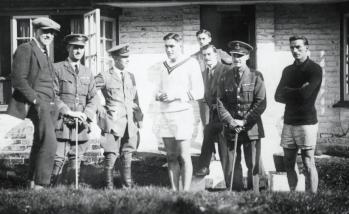
Saskatchewan has enjoyed widespread grassroots participation and international success in track and field (also called “athletics”) since the 1920s. Earl Thomson, born in Birch Hills but a California resident from the age of 8, insisted on representing Canada at the 1920 Summer Olympics in Antwerp and won the gold medal in the 110-metre men's hurdles in world-record time. American-born Ethel Catherwood, who moved to Scott as a toddler and then Saskatoon to finish high school, was a sensation at the 1928 Olympics in Amsterdam: already dubbed “The Saskatoon Lily” by Canadian reporters, she became a national heroine by winning the women's high jump. Stan Glover of Saskatoon was a bronze medallist on the men's 4x400-metre relay team in the same Olympics. School meets at both elementary and high school level became commonplace by the 1920s and, along with adult participation in the YMCA and other urban athletic clubs, established track and field's popularity. Saskatoon took pre-eminence and maintained it, in great part through the influence of a succession of three outstanding coaches: Joe Griffiths, who discovered and assisted Catherwood early in a career that would extend to the 1950s; Bob Adams, a former national decathlon champion who guided athletes from 1955 to 1983; and Lyle Sanderson, who led the University of Saskatchewan team from 1968 to his retirement in 2004. Griffiths, Adams or Sanderson played some role in the development of the majority of the province's elite athletes.
Aspiring runners, leapers and throwers have long been able to compete as early as grade school, while the Saskatchewan High Schools Athletic Association has maintained well-organized competition and adequate coaching standards since its inception in 1948. The University of Saskatchewan has long been a popular destination for athletes; the University of Regina's track and field program achieved more modest but tangible success by 2000. Many promising athletes have proceeded from secondary school to more competitive universities outside the province, especially in the United States where warmer climates and tougher competition are the norm. Saskatoon was also a leader in promoting athletics. It was Griffiths who organized the first provincial high school championships in 1922. The city has been a frequent venue for major events such as national championships and Olympic trials, and in 1965 began an annual indoor meet (soon to become the Knights of Columbus Games) that featured a blend of world-class stars and regional standouts. Vancouver sprinter Harry Jerome, born in Prince Albert, tied the world record for 100 metres (10.0 seconds) at the Olympic trials in Saskatoon on July 15, 1960; and American pole vaulter Bob Seagren set an indoor world record at the Knights of Columbus Games on December 29, 1966.
Pentathlete/heptathlete Diane Jones Konihowski of Saskatoon and middle-distance runner Lynn Kanuka Williams of Regina earned international acclaim in the 1970s and 1980s respectively: Jones Konihowski's pentathlon gold medal at the 1978 Commonwealth Games in Edmonton highlighted a decade of achievement; Kanuka earned the bronze medal in the women's 3,000 metres at the 1984 Olympics in Los Angeles, and was among the world's finest road and cross-country racers. In addition to a long string of participants in Olympics and other international competitions, Saskatchewan has also produced exceptional Paralympians. Arnold Boldt of Osler, who lost his right leg in a childhood farm accident, astonished the world with his high-jumping prowess, clearing as high as 2.08 metres in a career that included five Paralympic high jump gold medals (1976-92). Colette Bourgonje of Saskatoon, rendered a quadriplegic by a car accident at 18, became a world-class wheelchair racer and cross-country skier. Clayton Gerein of Pilot Butte has won twelve Paralympic medals, five of them gold, since 1988; and fellow wheelchair racer Lisa Franks of Moose Jaw was a double gold medallist at the 2004 Paralympics in Athens.
John Chaput
Print EntryHOME | BROWSE BY SUBJECT | ENTRY LIST (A-Z) | IMAGE INDEX | CONTRIBUTOR INDEX | ABOUT THE ENCYCLOPEDIA | SPONSORS TERMS OF USE | COPYRIGHT © 2006 CANADIAN PLAINS RESEARCH CENTER, UNIVERSITY OF REGINA | POWERED BY MERCURY CMS |
|||
| This web site was produced with financial assistance provided by Western Economic Diversification Canada and the Government of Saskatchewan. |
|||
 |
 |
 |
 |
| Ce site Web a été conçu grâce à l'aide financière de Diversification de l'économie de l'Ouest Canada et le gouvernement de la Saskatchewan. |
|||